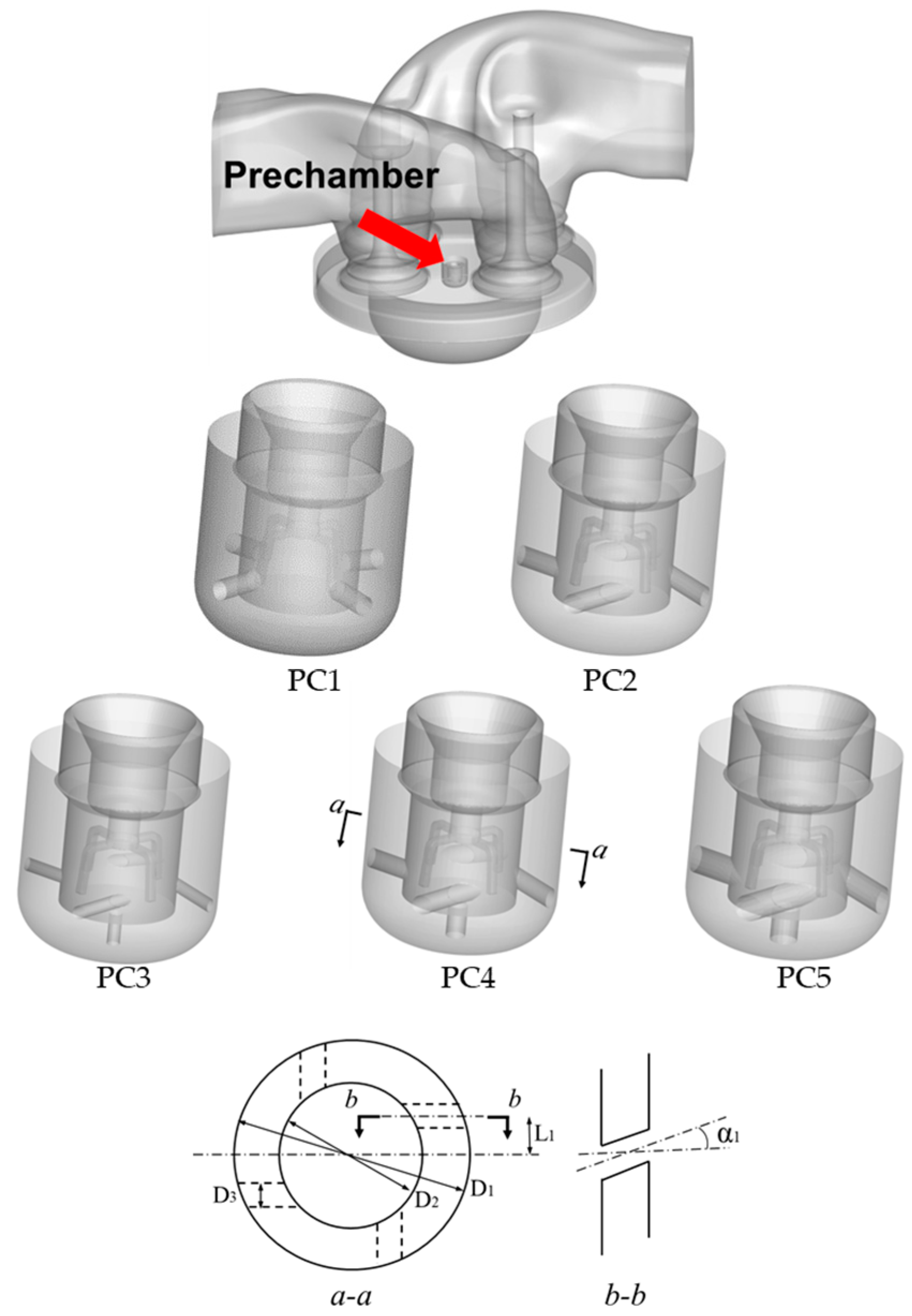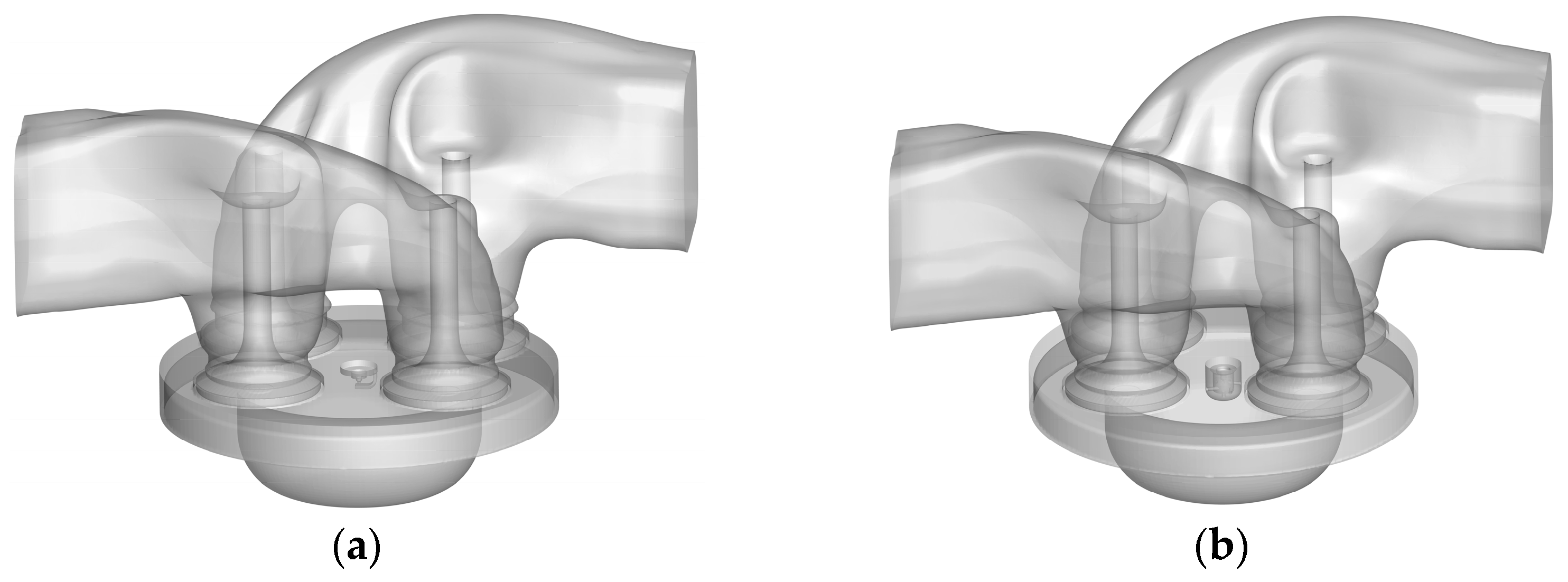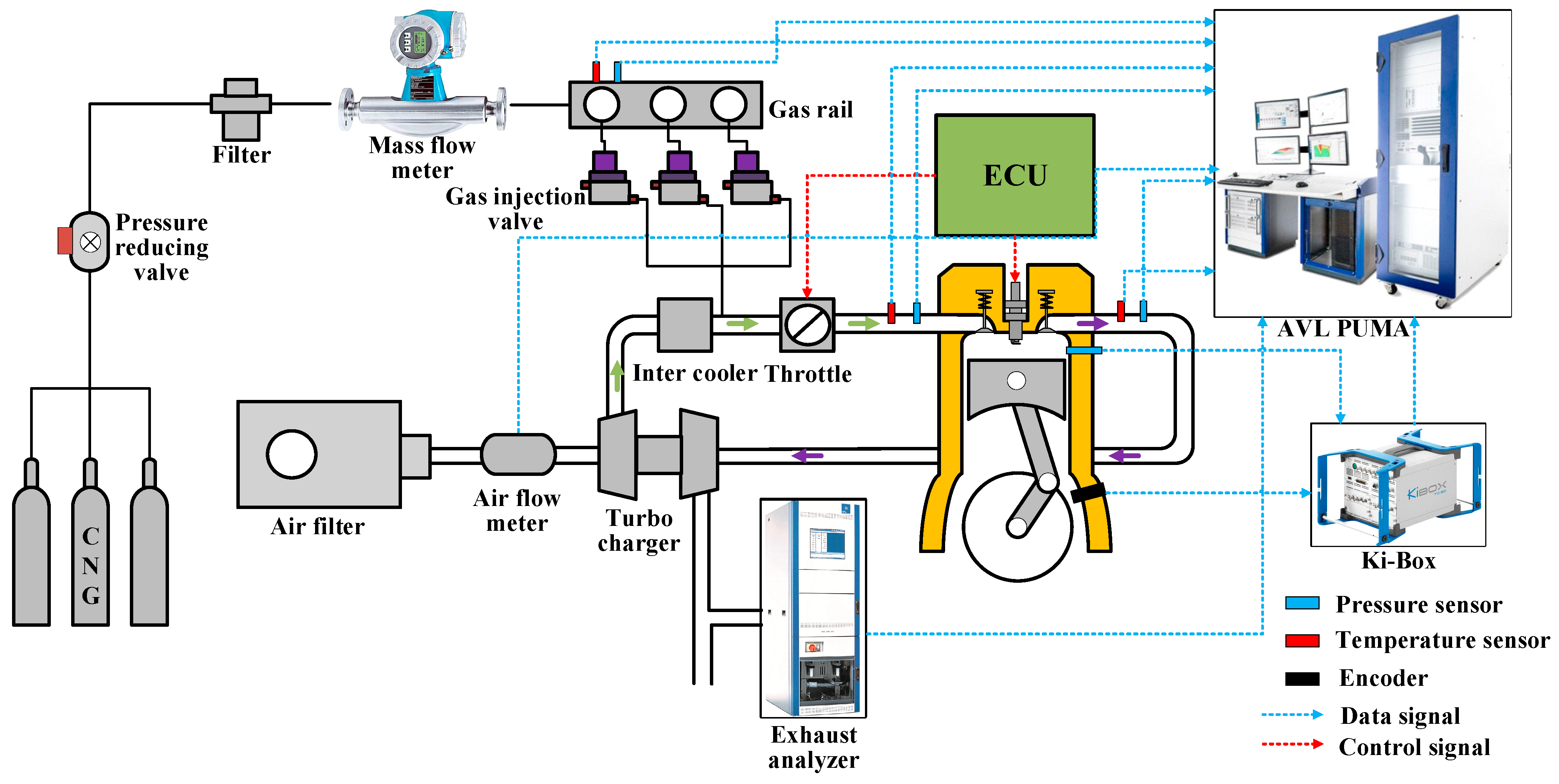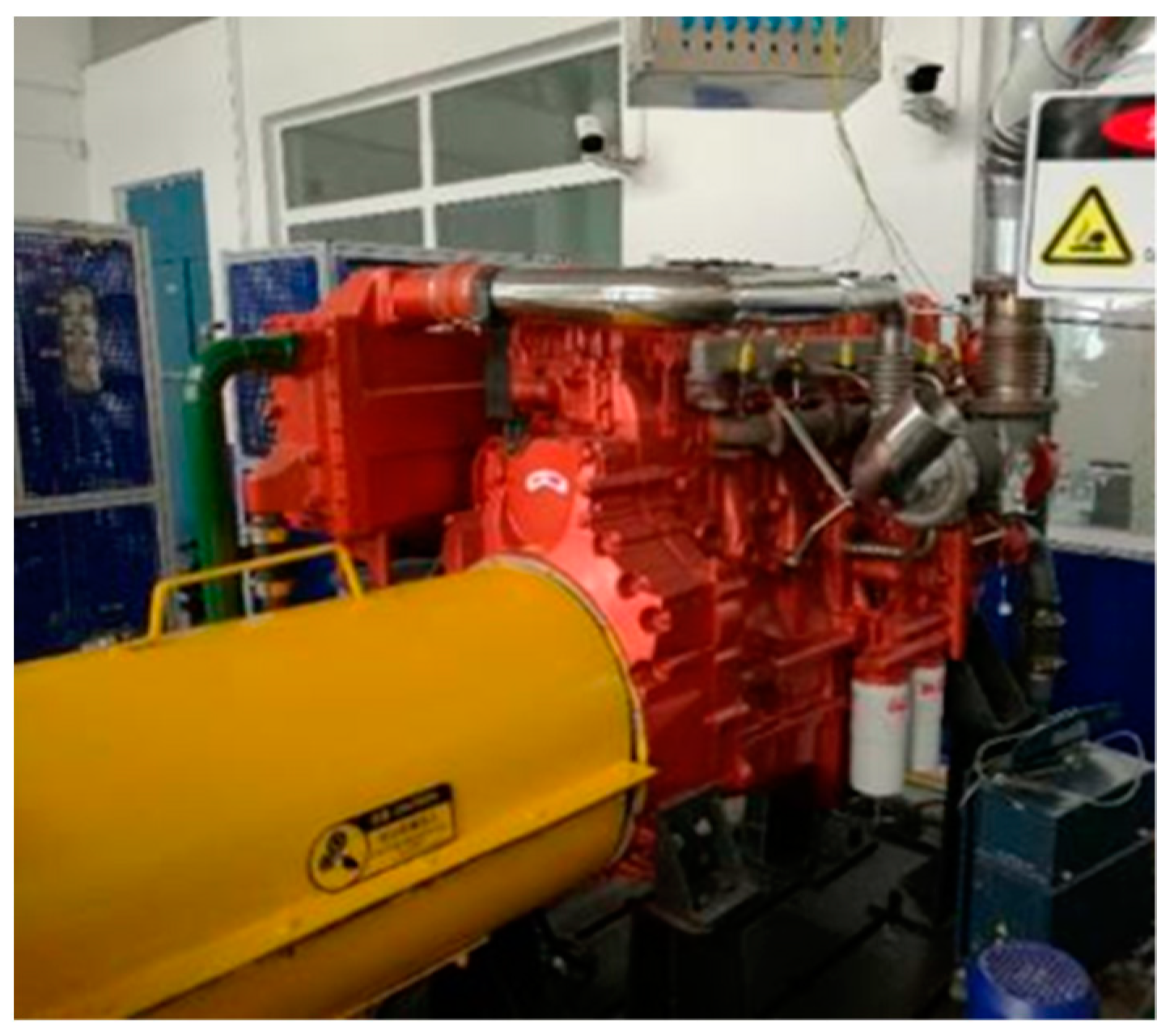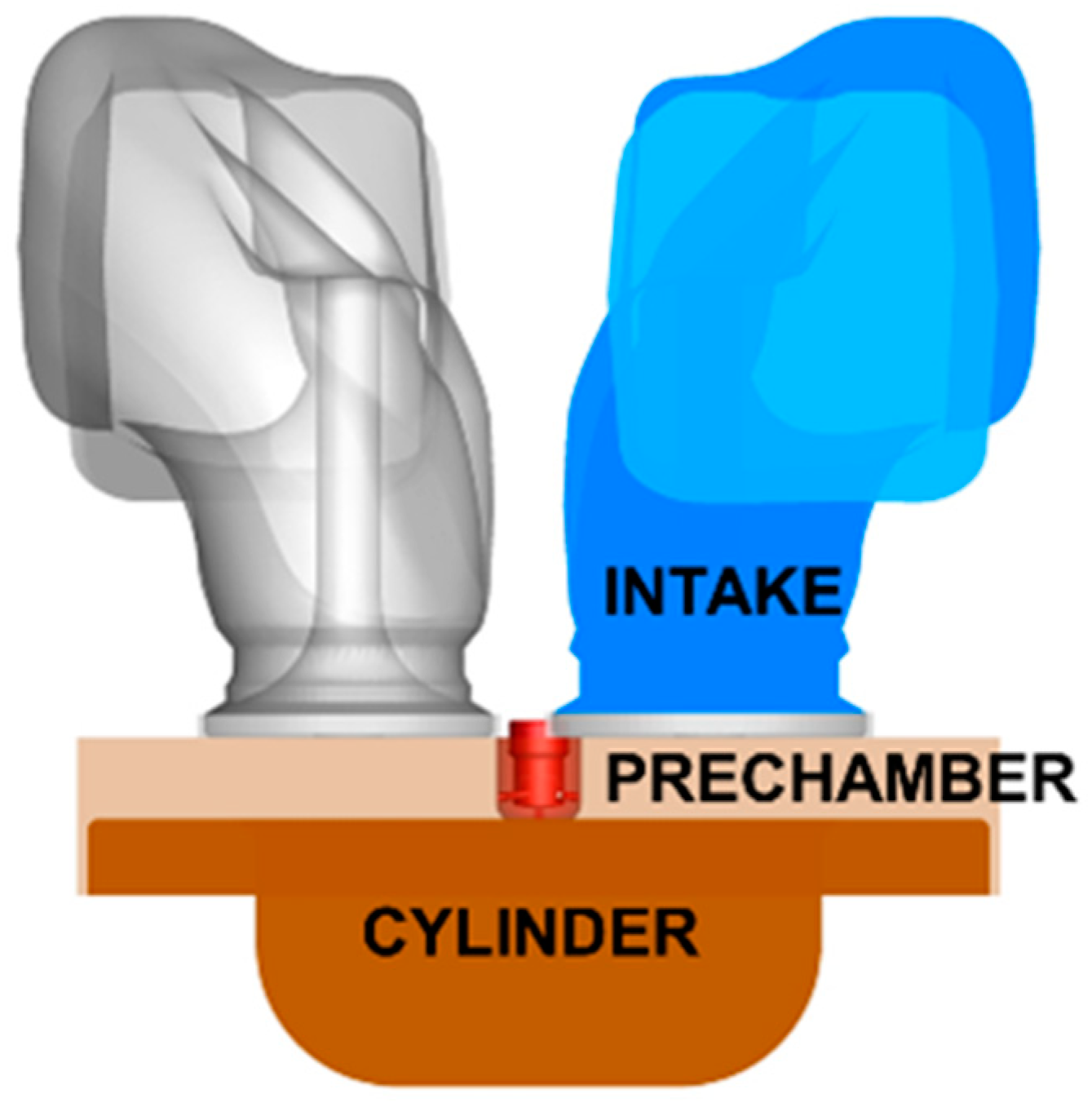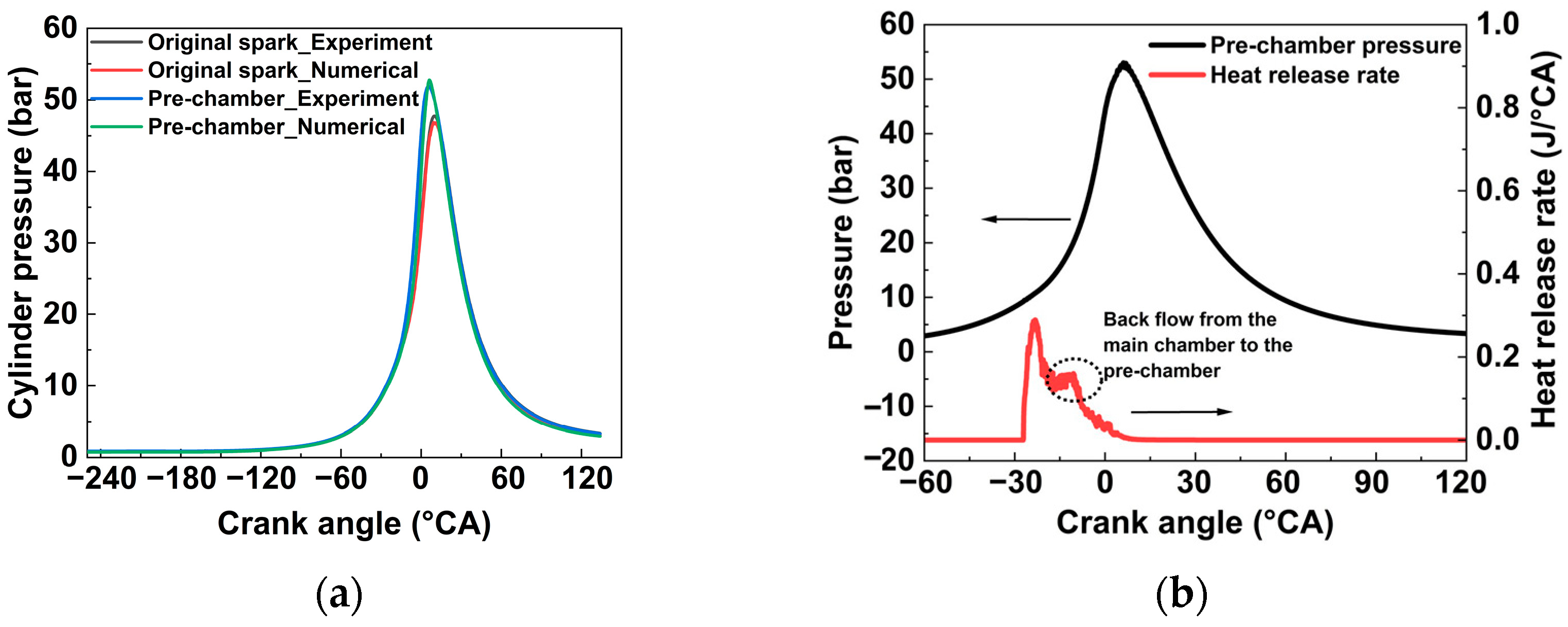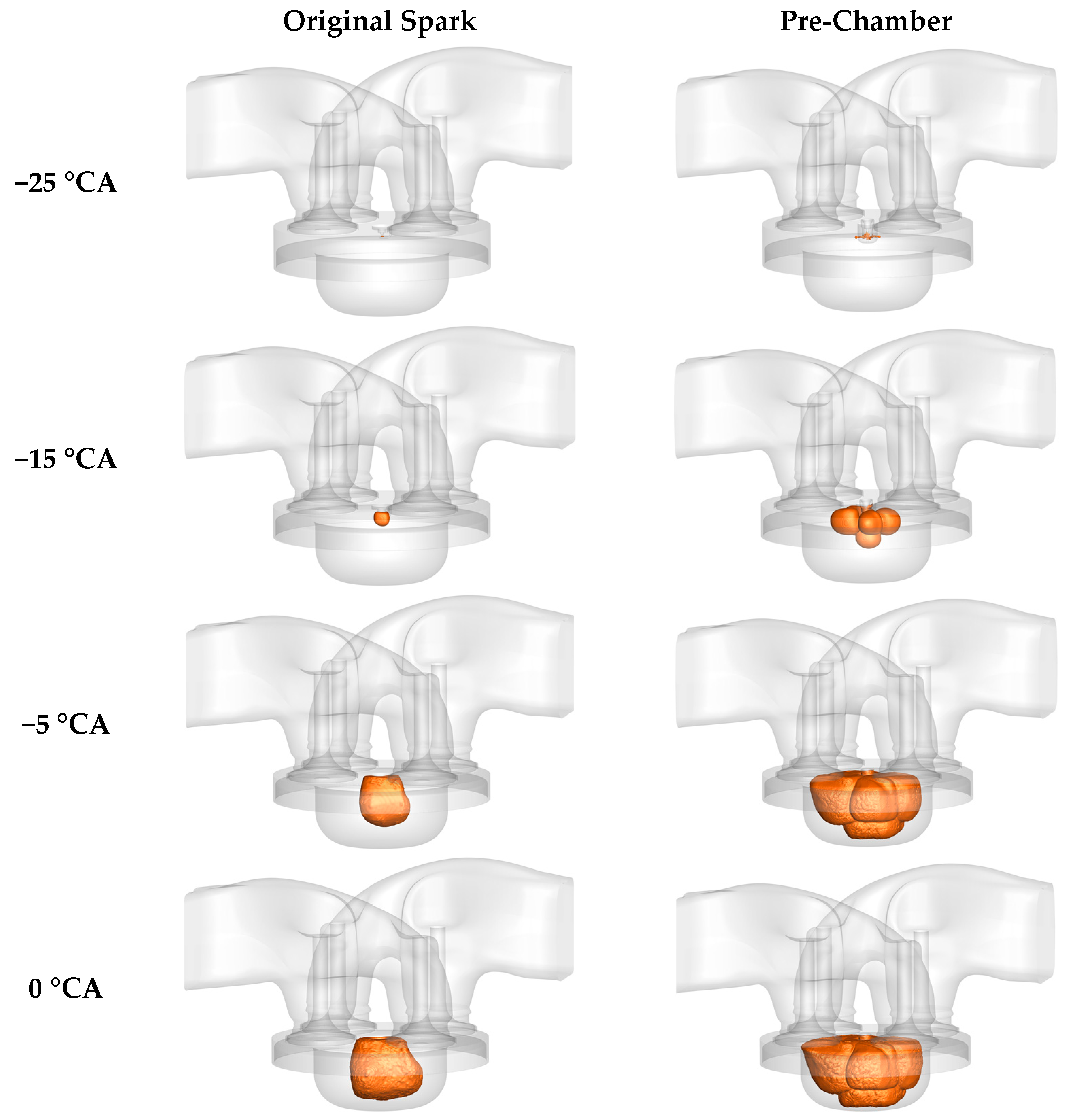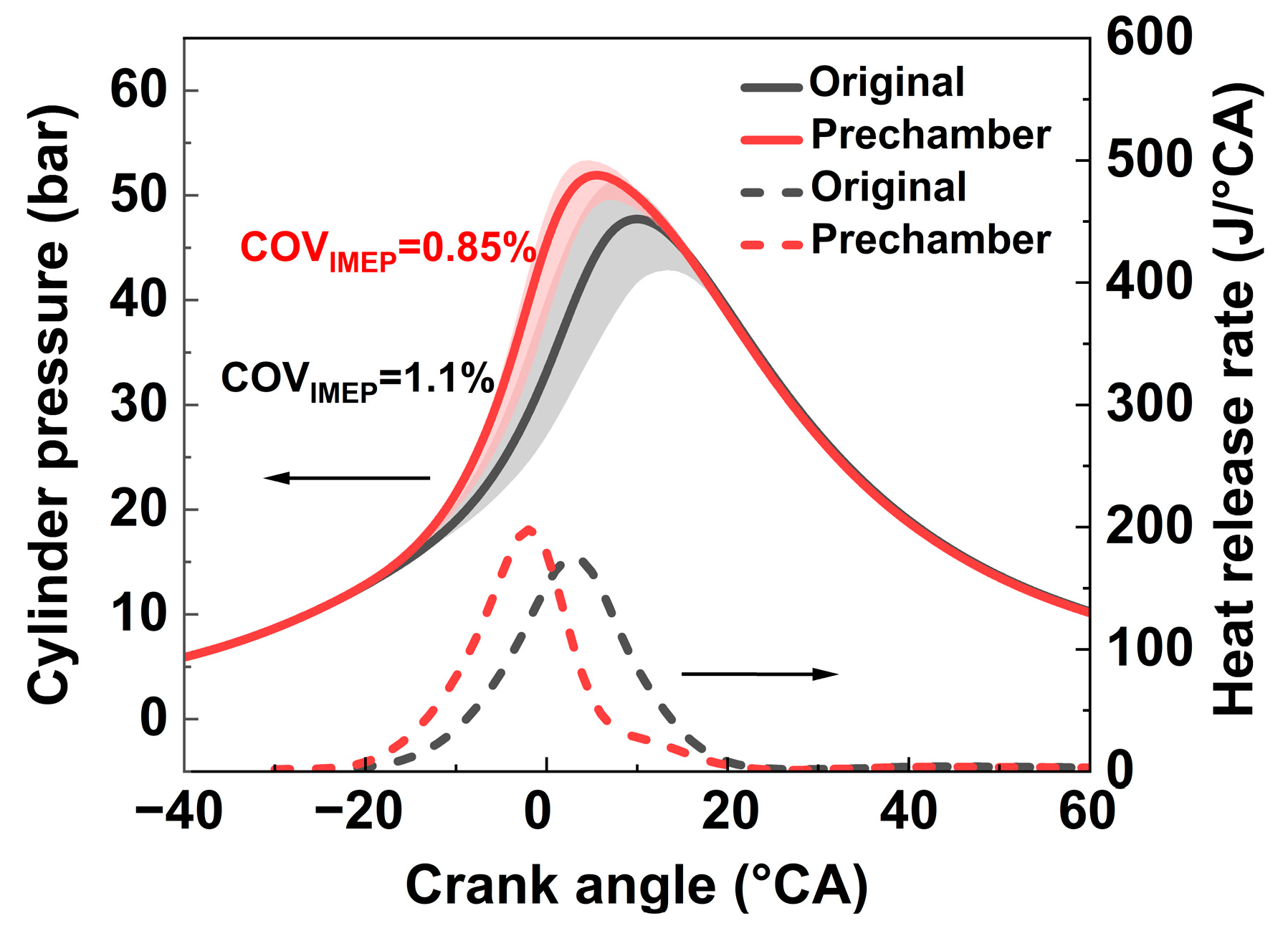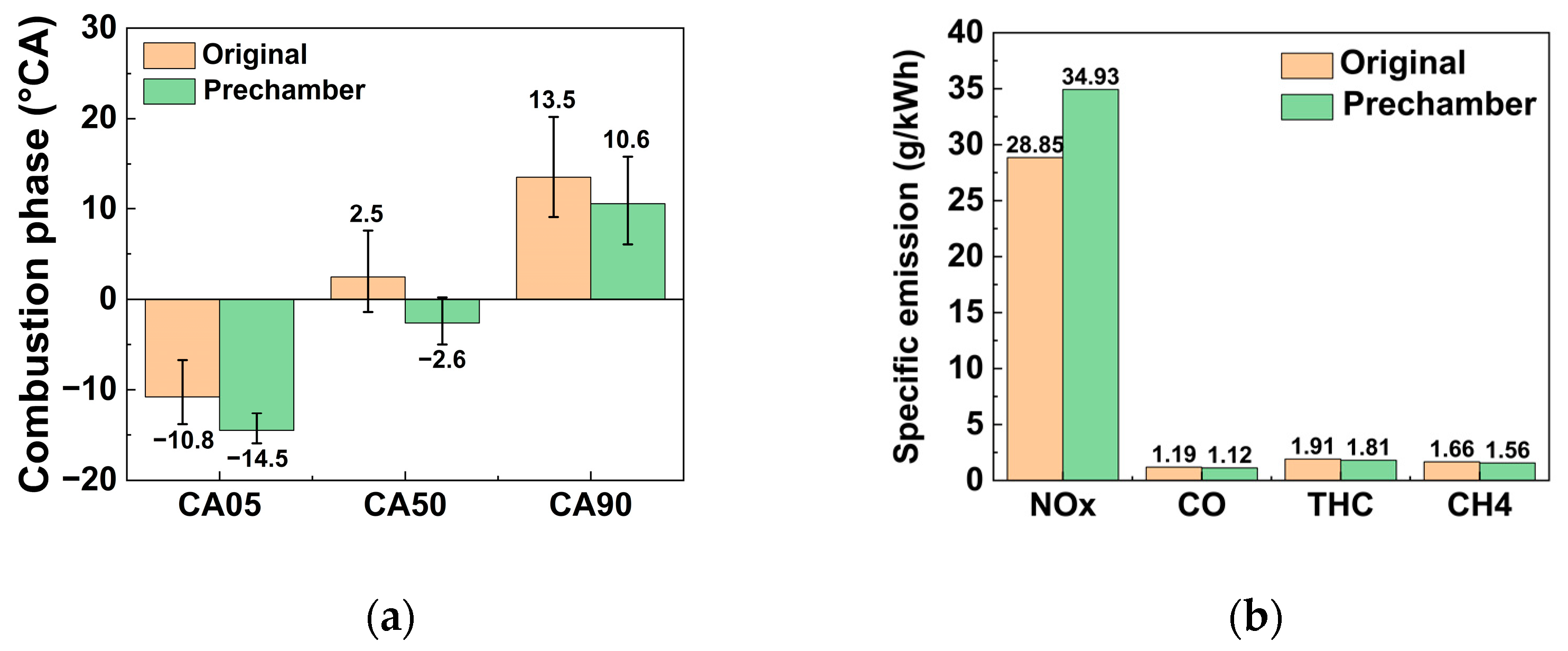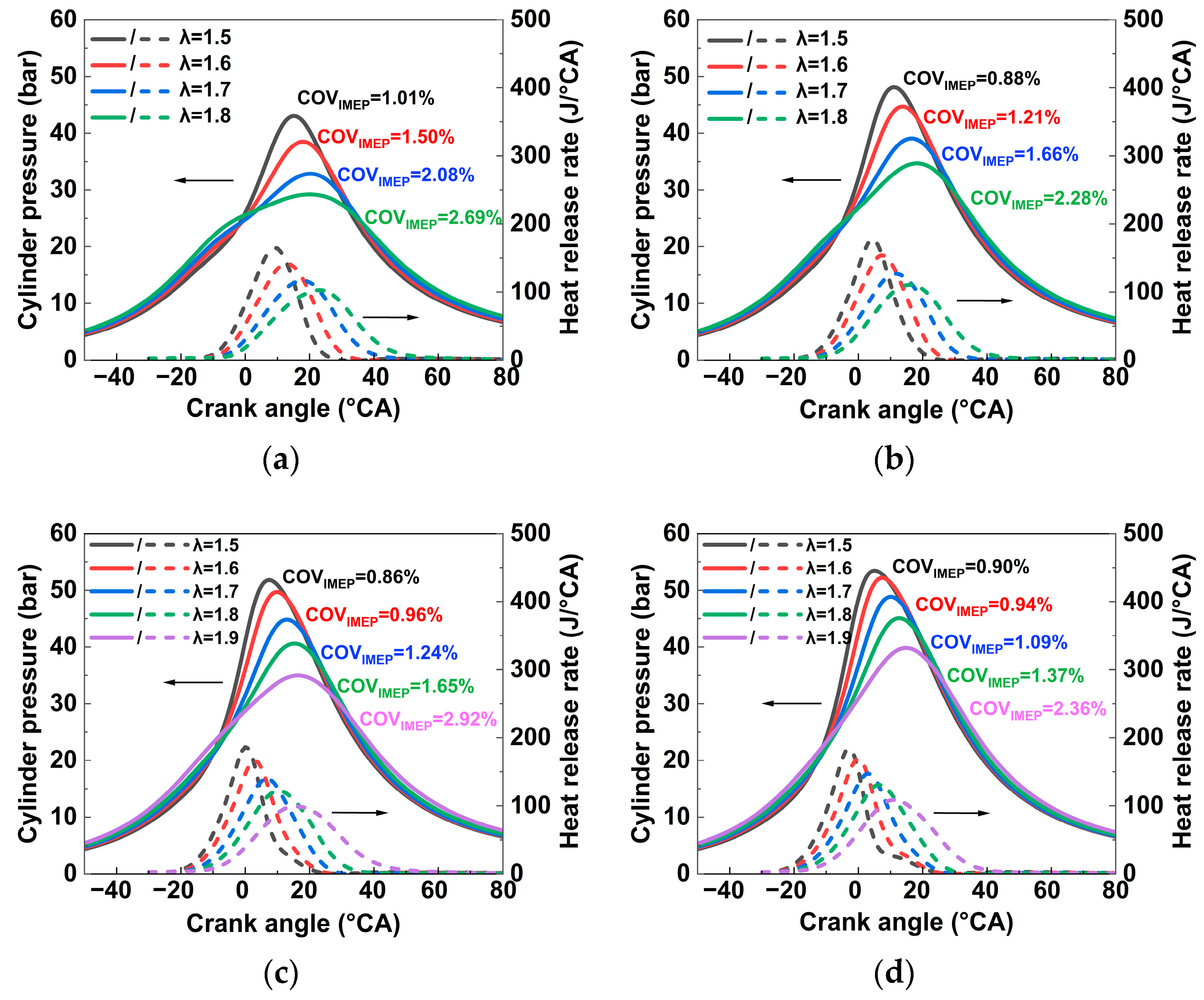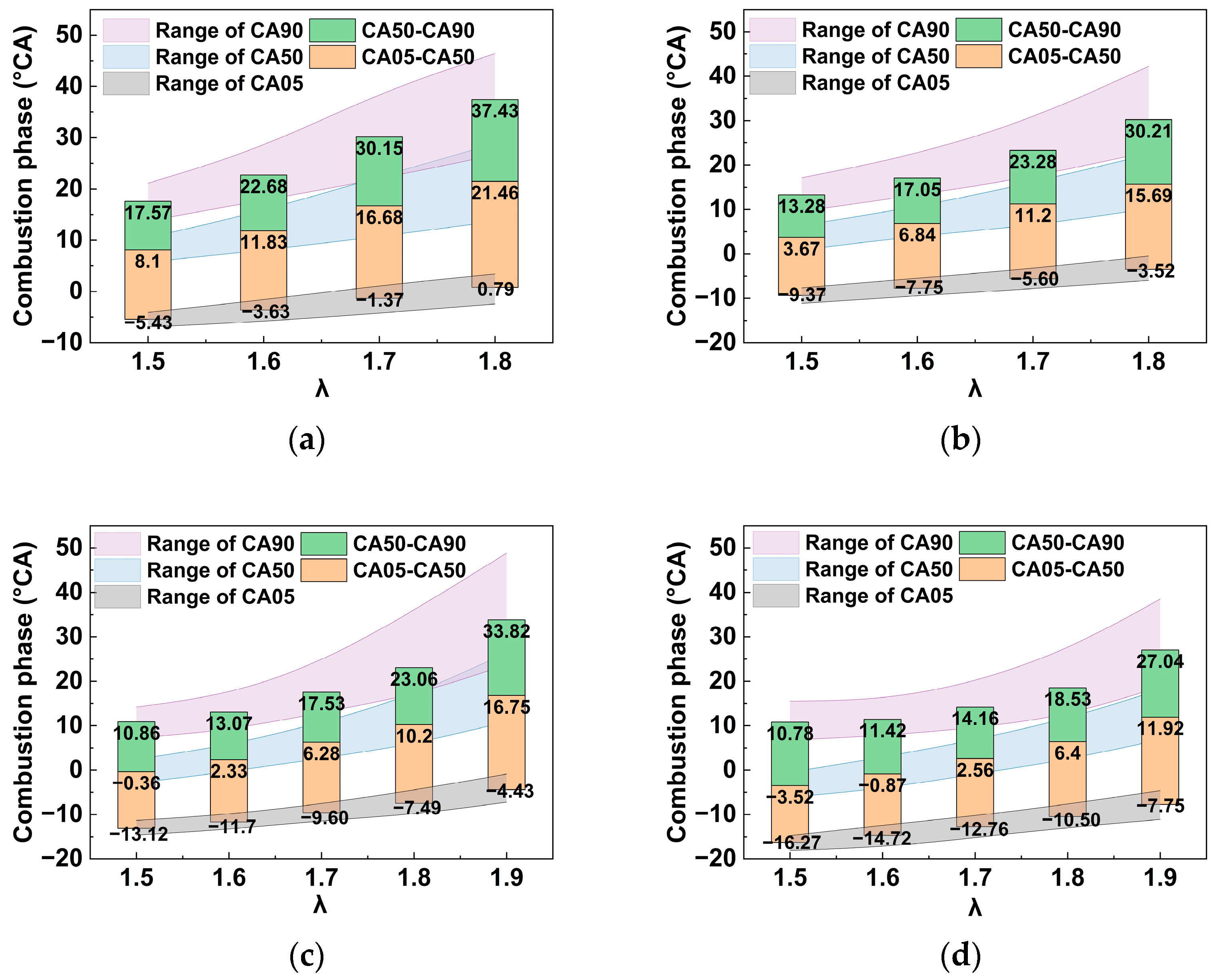1. Introduction
The increasingly prominent energy and environmental issues make the internal combustion engine face greater challenges in terms of emissions and economy. Natural gas has become the most reliable alternative fuel for traditional engines due to its advantages in reserves, price and producing almost no PM emissions [
1,
2,
3]. In the Chinese inland marine engine market, the application of natural gas engines is becoming more and more extensive. In 2016, the Chinese government issued emission regulations for inland marine engines, limiting the emission of PM, NOx, CO, and unburned HC. For vehicle natural gas engines, in order to meet strict emission regulations, the technical route of equivalence ratio combustion and three-way catalyst is generally adopted [
4]. However, for natural gas engines, lean-burn technology can improve the thermal efficiency and can increase the heat capacity of the working fluid, which will reduce the combustion temperature and NOx emissions [
5,
6]. For marine engines, the emission regulations are relatively loose compared with that of vehicle engines, so the lean-burn technical route can be tried to improve the engine economy and reduce the aftertreatment cost.
At the same time, lean-burn technology also faces problems such as difficulty in ignition under low and medium loads [
7,
8], and increased cyclic variation. For spark-ignition engines, the main factors for the increased cyclic variation are ignition delay and fluctuations in the initial stage of flame propagation. Therefore, improving the ignition energy and stabilizing the flow near the spark plug have become the urgent problems to be solved in lean combustion. Pre-chamber ignition, also known as turbulent jet ignition (TJI), can stabilize the flow near the spark plug by setting a pre-chamber around the spark plug [
9]. Jamrozik [
10] and Toulson et al. [
11] applied an active pre-chamber on a natural gas engine to explore the lean-burn limit. Serrana et al. [
12] used a pre-chamber on a gasoline engine to realize stable ultra-lean burn. After igniting the mixture in the pre-chamber, its high-temperature jet can ignite the mixture in the main combustion chamber. The ignition of the pre-chamber is mainly divided into four stages: (1) The scavenging of the pre-chamber. During the intake and compression strokes, the residual exhaust gas in the pre-chamber is discharged, and the fresh mixture is charged at the same time. (2) The pre-chamber ignition and combustion. The spark plug in the pre-combustion chamber ignites the mixture, and the flame begins to spread in the pre-combustion chamber. (3) Jet ignition. The high-temperature jet in the pre-combustion chamber ignites the mixture in the main combustion chamber. (4) Main combustion. A flame begins to spread in the main combustion chamber. The pre-chamber is divided into two types according to its fuel supply mode, active pre-chamber and passive pre-chamber. The active pre-combustion chamber is provided with a fuel injection valve in the pre-combustion chamber, which directly provides gas for the pre-combustion chamber. The passive pre-chamber supplies the pre-chamber with the mixture entirely through the ventilation process. Due to the existence of a gas injection valve, an active pre-combustion chamber can improve the ignition stability, but it is difficult to modify, and its cost is high.
Ultra-lean combustion can effectively reduce the NOx emission of an engine, which also has high requirements for the ignition capacity of the engine. The pre-chamber can quickly and effectively improve the combustion in the cylinder due to its convenient modification, but its performance is largely affected by its structural design. Previous researchers have explored the structure of the pre-chamber to optimize the engine combustion. Novella et al. carried out simulation and experimental research on the passive pre-chamber on a gasoline engine [
13] and applied two kinds of pre-chamber with different volume and nozzle diameter to the engine. The study was carried out under different excess air ratio (λ) and exhaust gas recirculation (EGR) rate. The results show that the maximum λ of the engine can reach 1.6, and it is considered that the limiting factors of λ are the decrease of laminar flame speed and the residual gas in the pre-chamber. To further extend the lean-burn limit, they added hydrogen to the cylinder and made the λ reach 1.9 [
14]. They also found in the latest research that increasing the combustion rate in the pre-chamber is crucial to improving the combustion in the main chamber [
15]. For natural gas engines, the application of a pre-chamber can improve the thermal efficiency of engines at different EGR rates under stoichiometric ratio [
16]. However, no further research has been carried out on extending the lean limit and emission control. Bunce et al. [
17] explored the effect of nozzle diameter on the active pre-chamber jet and engine performance through visualization experiments and engine experiments. It is believed that a pre-combustion chamber with multiple holes and a small hole diameter is beneficial to improve the thermal efficiency of the engine, but too small a hole diameter will cause the flame to quench and cause the engine to misfire. Zhou et al. [
18] carried out an experimental study on a 7-hole active pre-combustion chamber. The adoption of the active pre-combustion chamber made the λ of the gasoline engine reach 2.2, while achieving extremely low NOx emissions. Gessica et al. [
19] applied an active pre-chamber to a natural gas engine to explore the effect of nozzle diameter on engine performance; the λ can reach 2.0 under an IMEP of 1.0 MPa. In terms of spark plug shape, the research of Wallesten et al. [
20] believes that the type, direction, location and electrode gap of the spark plug have an important influence on the development and combustion of the fire nucleus. However, the study of Attard et al. [
21] considered that the design of the spark plug had little effect on the TJI combustion when the mixture in the pre-combustion chamber could be ignited. Biswas et al. [
22] explored the combustion of TJI under different methane λ (1.0–1.6) through visualization experiments, and summarized ignition results in a diagram of turbulent combustion regime.
According to the current research, the pre-chamber can effectively increase the ignition energy and improve the lean-burn combustion. It is conducive to extend the lean-burn limit to reduce NOx emission. For an active pre-chamber, its application can extend the lean-burn limit to λ 2.0 due to the independent internal fuel supply. However, the structure of an active pre-chamber is relatively complex, and it is difficult for the engine to apply. For the passive pre-chamber, its structure is relatively simple, which makes it easier to apply to the engine. However, the extension of the lean-burn limit is restricted by the scavenging capacity of the pre-chamber. At present, there is relatively little research on the scavenging capacity of passive pre-chambers.
In this paper, focusing on the low-load working condition, several kinds of passive pre-chambers are designed, and CFD simulation is carried out to explore the influence of nozzle direction, nozzle number and nozzle diameter on the scavenging process. At the same time, in order to increase the combustion rate in the pre-chamber, a claw-shaped electrode is applied to realize multi-point ignition in the pre-chamber. CFD simulation is carried out to investigate the influence of the application of a pre-chamber on engine combustion. Finally, the passive pre-chamber is applied to a 6-cylinder natural gas engine to compare its performance with that of the original engine. The lean-burn limit of the engine is explored under different ignition timing, and the combustion and emission performance of the engine are also analyzed.
3. Results
3.1. Simulation Study on Scavenging Process Inside the Pre-Chamber
The passive pre-chamber is beneficial to improve the ignition energy and extend the lean-burn limit of a natural gas engine. However, under low-load working condition, the flow inside the cylinder is weak which is not conducive to the scavenging of the pre-chamber. In this paper, five different structures of pre-chamber are designed to investigate the influence of hole direction, hole number and hole diameter on the scavenging process. The diagram of simulation is shown in
Figure 5, and the gases from the intake port, pre-chamber and cylinder are defined by different names. PRECHAMBER and CYLINDER represent the exhaust gas from the previous cycle, and INTAKE represents the fresh charge. During the intake and compression strokes, the composition inside the pre-chamber is quantified until the ignition timing (−27 °CA).
Figure 6 shows the variation of gas components inside the pre-chambers. It can be seen from the figure that the discharge of the exhaust gas in the pre-chamber mainly occurs during the intake stroke. During the compression stroke, a large amount of fresh charge enters the pre-chamber. This process mainly starts from 100 °CA before top dead center. At the same time, a certain proportion of residual gas in the cylinder also enters the pre-chamber with the fresh charge.
PC1 and PC2 are 4-hole pre-chambers; for the nozzles of PC2, an offset L
1 is set to generate vortex in the pre-chamber. From
Figure 6, the influence of nozzle direction on the scavenging process is limited. The total mass in PC1 and PC2 is 1.96 mg and 1.95 mg, respectively; the fresh charge proportions are 88.9% and 89.1%, respectively.
Compared with PC2, PC4 has an extra hole at the bottom to improve the scavenging process in the pre-chamber. According to the results, the improvement is limited. The total mass in the pre-chamber increases from 1.95 mg to 1.97 mg at the ignition timing. The proportion of residual gas in the pre-chamber decreased from 3.7% to 2.7%, and the proportion of fresh charge increased from 89.1% to 90.3%.
PC3, PC4 and PC5 are 5-hole pre-chambers with nozzle diameter of 0.8 mm,1.2 mm and 1.6mm, respectively. With the increase of nozzle diameter, the total mass of gas in the pre-combustion chamber at the ignition timing increases slightly. At the same time, due to the increase of nozzle diameter, the proportion of fresh charge in the pre-chamber also increases, reaching 86.8%, 90.3% and 92.1%, respectively. The increase of nozzle diameter has a significant effect on the reduction of residual gas in the pre-chamber. With the increase of nozzle diameter from 0.8 mm to 1.6 mm, the residual gas in the pre-combustion chamber decreases from 5.9% to 1.0% at ignition timing.
From the results above, it can be concluded that the exhaust gas in the pre-chamber is mainly discharged during the intake stroke, and the fresh charge mainly enters the pre-chamber during the compression stroke. At the same time, a certain proportion (about 7%) of exhaust gas in the cylinder enters the pre-chamber, which is nearly not affected by the structure of the pre-chamber. The nozzle diameter has a significant effect on the discharge of the residual gas in the pre-chamber, which mainly happens during the intake stroke. The scavenging capacity of PC4 is better than that of PC1, 2, 3, although it is slightly worse than that of PC5, but the large nozzle diameter of PC5 will reduce the flame jet penetration. Therefore, PC4 was finally selected for further study in this paper.
3.2. Simulation Research of Original Spark Plug and Pre-Combustion Chamber
In order to further study the combustion conditions inside the pre-chamber and explore their influence on the combustion process in the cylinder, CFD was used to simulate the passive pre-chamber and the original spark plug under experimental conditions; the settings of models and boundary conditions are listed in
Table 2.
Figure 7a below shows the cylinder pressure comparison between simulation and experiment. The model can accurately reflect the pressure trend in the cylinder, and the maximum error of the original spark plug and the pre-chamber is 2.1% and 1.5%, respectively.
Figure 7b shows the pressure and heat release rate inside the pre-chamber; the pressure inside the pre-chamber is very similar to that in the main chamber, because the volume of the pre-chamber is relatively small. From the heat release rate in the pre-chamber, we can see that there exists a second peak in the curve. This is due to the back flow from the main chamber to the pre-chamber. After the flame jet ignites the mixture in the main chamber, the pressure at the exit of the nozzle rises and generates the back flow to the pre-chamber.
Figure 8 below shows the velocity field distribution in the pre-combustion chamber and the near field of the spark plug at the time of ignition. At the time of ignition, the velocity of the flow field near the original spark plug is low and unevenly distributed, which is not conducive to flame propagation after ignition. The setting of the passive pre-combustion chamber nozzle can guide the vortex in a fixed direction, so that the flow near the spark plug is more stable, thereby improving the stability of ignition, reducing the fluctuation of CA05 and cyclic fluctuation. At the same time, the increase of the flow velocity in the pre-combustion chamber is beneficial to accelerate the flame propagation after ignition.
Figure 9 below shows the comparison of flame propagation between the passive pre-combustion chamber and the original spark plug after the ignition time. The flame is represented by the 2000 K isothermal surface. It can be seen from the figure that the flame development speed of the original spark plug is slow after ignition, which is due to the velocity distribution near the spark plug. The claw-shaped electrode and the existence of the internal vortex inside the passive pre-chamber accelerates the development of the flame, and the internal flame has developed to the nozzle outlet at −25 °CA. The high-temperature flame ejected from the nozzle holes significantly increases the combustion speed in the main combustion chamber, makes up for the shortcoming of the natural gas engine’s slow combustion speed under lean combustion and is conducive to further expanding the lean-burn limit of the engine. The lean-burn limit of an engine determines the degree to which its NOx emission is reduced, so it needs to be tested on the engine to explore its lean-burn limit as well as combustion and NOx emission conditions.
3.3. Performance Comparison of Original Spark Plug and Pre-Combustion Chamber
This paper studies the low-load condition of the marine engine. At the 25% load operating point of the propulsion characteristics, the speed is 945 r/min, the power is 54.5 kW, and the BMEP is 0.535 MPa. First, carry out a comparative study on the original spark plug and the pre-chamber. Based on not changing parameters such as ignition timing and λ, the original spark plug is replaced with a pre-chamber, and the application of the pre-chamber is compared to the combustion and emission.
Figure 10 shows the comparison of cylinder pressure and heat release rate between the original spark plug and the passive pre-chamber. It can be seen from the figure that under the same λ and ignition timing, the application of the passive pre-chamber makes the combustion process more advanced. This is due to the claw-shaped spark plug which can realize multi-point ignition, and the electrode is closer to the outlet of the pre-chamber. In addition, the inclination angle of the nozzle hole strengthens the turbulent kinetic energy in the pre-chamber, thereby accelerating the flame propagation process in the pre-chamber. The above reasons improve the in-cylinder combustion process. From the aspect of cycle variation, the
COV of IMEP is an important index to measure the cyclic change. The calculation formula of
COV is as follows:
Among them, COV is the coefficient of cyclic variation, is the average value of variables, σ is the standard deviation, and N is the number of samples. In the results, we can see that the COVIMEP is reduced from 1.1% of the original machine to 0.85% after applying the pre-combustion chamber. For spark-ignition natural gas engines, among the factors that cause cycle variation, the fluctuation of combustion phasing is the main reason. Since the variation of the flow field near the spark plug will cause the inconsistency of flame propagation, resulting in cycle variation, the application of the pre-chamber can effectively improve the consistency of the flow field near the spark plug, thereby achieving stable combustion.
Figure 11a shows the comparison of the combustion phase between the original spark plug and the pre-combustion chamber. It can be seen from the figure that after the passive pre-combustion chamber is applied, the combustion process in the cylinder is obviously advanced, and the CA05 is advanced by 3.7°, which indicates that the passive pre-chamber will speed up the initial combustion progress after ignition. The application of the chamber can shorten the ignition delay period at low load, and the CA50 is advanced by 5.1°, indicating that TJI accelerates the combustion rate after ignition. From the fluctuation of various parameters, after the passive pre-combustion chamber is applied, the fluctuation of the CA05 is significantly reduced. This is because the passive pre-combustion chamber and the design of the hole make the flow field near the spark plug more stable at the time of ignition. Therefore, the in-cylinder combustion is more stable, which is also the main reason for the reduction of the engine cycle fluctuation.
Figure 11b below shows the comparison of the emission of the original spark plug and the pre-chamber. After the passive pre-chamber is installed, the NOx emission increases significantly, which is caused by the advance of the combustion phase and the increase of the combustion temperature. In addition, the CO, THC and methane emissions of the engine are slightly reduced, mainly because the combustion cycle fluctuation is reduced, and the in-cylinder combustion is more sufficient. Chinese inland marine engine emission regulations [
26] have the following limits for each emission: NOx + NMHC (THC-CH
4) ≤ 5.8 g/kWh, CO ≤ 5.0 g/kWh, CH
4 ≤ 1.0 g/kWh (CH
4 emission is temporarily unrestricted). Therefore, the emission level of NOx must be greatly reduced. Increasing the degree of lean combustion of the engine is an effective way to reduce NOx emission without using aftertreatment equipment. The application of the passive pre-chamber can effectively increase the combustion rate, thereby improving the combustion stability in the cylinder, which is very important for extending the lean-burn limit of the engine. In the subsequent part, the lean-burn limit of the engine at different ignition timing will be explored. With the realization of ultra-lean burn, the NOx emission will reduce significantly. The lean-burn limit of the engine needs to be explored.
3.4. Performance Exploring of Passive Pre-Chamber
From the research in the previous part, the passive pre-combustion chamber can speed up combustion and improve the stability of the in-cylinder combustion under low load. Therefore, it is necessary to explore the engine performance under different λ and ignition timing, to clarify the lean-burn limit and provide guidance for the selection of engine technical route. Cylinder pressure, heat release rate, combustion phasing, cycle variation and emissions at different λ and ignition timings are discussed below.
3.4.1. The Effects of Ignition Timing and λ on Cylinder Pressure, Heat Release Rate
Figure 12 shows the cylinder pressure, heat release rate and cyclic variation of the engine with different lean-burn degrees at different ignition timings. It can be seen from the figure that at the same ignition time, the increase of λ in the cylinder leads to the delay of the combustion process, the decrease of the peak heat release rate and the prolongation of the combustion process, which reduces the peak pressure in the cylinder. At the same time, the cyclic variation also increases as λ increases. When the ignition timing is 17 °CA BTDC and 22 °CA BTDC, the engine can achieve stable combustion within λ 1.8. With the advance of the ignition timing, when the ignition timing is 27 °CA BTDC and 32 °CA BTDC, the maximum λ of the engine can reach 1.9, which is due to the advance of the ignition timing to make up for the low combustion speed caused by the increase in λ. It can be seen from the figure that under the same λ, with the advance of the ignition timing, the engine cyclic variation tends to decrease gradually.
3.4.2. The Effects of Ignition Timing and λ on Combustion Phase
Figure 13 below shows the change of the combustion phase of the engine and the fluctuation range of each combustion phase with the increase of λ at different ignition times. It can be seen from the figure that at each ignition time, CA05, CA50 and CA90 have different degrees of delay with the increase of λ, and the combustion duration gradually increases. From the fluctuation range of each combustion parameter, the fluctuation range of CA05 is small, because the application of the passive pre-chamber improves the consistency of the flow field near the spark plug, so the ignition stability is also guaranteed. However, CA50 and CA90 show a larger fluctuation range under high λ conditions, which is due to the combustion velocity fluctuation caused by in-cylinder turbulence while the flame propagation velocity is reduced. At the same time, with the advance of the ignition timing, the fluctuation range of the combustion phase is gradually reduced, and the combustion duration is gradually shortened, which is beneficial to reduce the cycle fluctuation of the engine.
3.4.3. The Effects of Ignition Timing and λ on Specific Emission
Figure 14 below shows the MAP of engine emissions at different ignition timing and λ. In terms of NOx emission, in order to meet the requirements of emission regulations, the λ of the engine needs to be above 1.6, and with the further increase of λ, the NOx emission is further reduced, which can be as low as 0.34 g/kWh when λ is 1.9. At this time, the ignition timing of the engine can have more adjustment space to optimize engine thermal efficiency and other emissions. In terms of CO emissions, since the limit of emission regulations is 5.0 g/kWh, the requirements of emission regulations can be met under all operating conditions, indicating that incomplete combustion under low load is effectively controlled. In terms of CH
4 emission, the limit of emission regulations is 1.5 g/kWh, so it is difficult to meet the regulatory requirements by adjusting λ and ignition timing. However, at present, the Chinese emission regulations do not impose mandatory requirements on CH
4 emissions for the time being and are only used as monitoring values. In conclusion, the application of pre-chamber can realize ultra-lean burn on the test engine under low-load working condition and reduce the specific emissions under the CHINA II regulation limit.
4. Discussion
In this paper, in order to optimize the performance of the passive pre-chamber under low engine load, several passive pre-chambers were designed. The influence of the direction, number and diameter of nozzle on the scavenging capacity of the pre-chamber was studied by CFD simulation. By defining the names of the gases in different regions, the variation of the components in the pre-chamber were quantitatively analyzed, and the scavenging process of the passive pre-chamber was further understood. For passive pre-chambers, the scavenging process has a great impact on their performance, so this can be used as an evaluation index in the design process. At the same time, it is proved that the new passive pre-combustion chamber can accelerate the combustion rate and improve the combustion stability compared with the original spark plug. Finally, an engine test was carried out on a 6-cylinder natural gas engine to explore the performance with the application of the pre-chamber. The combustion and emission conditions under different ignition times and λ were studied. The results show that:
(1) In the scavenging process of the pre-chamber, the fresh charge enters the pre-chamber during the compression stroke and the discharge of residual gas in the pre-chamber mainly happens in intake stroke. A certain percentage (about 7% in this case) of cylinder residual gas will enter the pre-chamber along with the fresh charge, and it has a weak relationship with the structure of the prechamber. Compared with the nozzle direction and nozzle number, the nozzle diameter has a more obvious effect on the discharge of residual gas in the pre-chamber.
(2) The simulation results show that the design of the nozzle can generate vortex in a fixed direction inside the chamber, which will accelerate the flame propagation. Combined with the claw-shaped electrode, the flame can spread to the outlet of the nozzle within 2 °CA after ignition. With the application of this pre-chamber, the combustion in the main chamber can significantly be accelerated, which is crucial for the extending of the lean-burn limit.
(3) In the engine test, the application of the pre-combustion chamber can shorten the ignition delay period of the mixture and improve the combustion rate, which is crucial to the extending of the lean-burn limit. The extension of the lean-burn limit under different ignition timings is tested. When the ignition timing is 17 and 22 °CA BTDC, the maximum λ can reach 1.8. At ignition times 27 and 32 °CA BTDC, the engine λ can reach a maximum of 1.9, and the COVIMEP at this time is 2.36%, which means the combustion is still stable.
(4) The extending of the lean-burn limit aims at reducing the NOx emission. In terms of emissions, after the application of the pre-chamber, the NOx emission decreased from 28.85 g/kWh to 0.34 g/kWh, which is far lower than the requirements of the emission regulations. At the same time, the CO emission is 3.55 g/kWh, which is also lower than the limit of the emission regulations. Although CH4 exceeds the legal limit, since the emission of CH4 is currently only used as a record and is not mandatory, it can be optimized by increasing the compression ratio in the future.
From the above results, it can be seen that the application of passive pre-chamber can effectively improve the combustion stability under lean-burn working conditions, thereby extending the lean-burn limit and reducing NOx emissions. In the future, we can try to install a pressure sensor inside the pre-chamber and monitor the combustion in the pre-chamber and main combustion chamber simultaneously. This enables more accurate calibration of combustion model and thus accurate prediction of the combustion.
